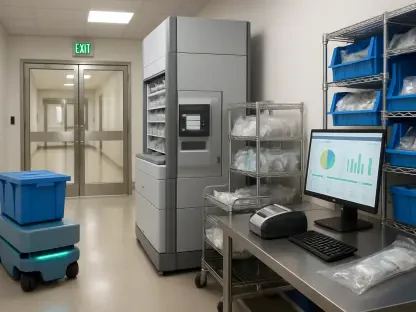The rise in ransomware attacks on healthcare providers has brought new urgency to the discussion on cybersecurity within the healthcare sector. With groups like the Trinity Ransomware group targeting organizations in both the United States and the United Kingdom, it’s clear that traditional security measures are no longer enough. Given the unique vulnerabilities inherent to healthcare institutions, the need for advanced cybersecurity strategies has never been more evident.
Healthcare institutions are particularly vulnerable due to outdated data infrastructure and a failure to adopt next-generation security measures. The impact of these cyber threats extends beyond IT departments, compromising patient data security and hampering healthcare delivery. In light of this, experts like Simon Bain, CEO of OmniIndex, advocate for the integration of blockchain technology, fully homomorphic encryption (FHE), and AI-driven real-time threat detection to bolster defenses.
The Escalating Threat Landscape
Frequency and Impact of Cyberattacks
Healthcare providers are increasingly becoming frequent targets for cybercriminals, with ransomware being a particularly prevalent threat. Attackers often employ double extortion tactics, where they not only steal and encrypt data but also threaten to release this information publicly if the ransom is not paid. These attacks create multiple layers of vulnerability, seriously endangering the confidentiality and integrity of patient data.
Real-world instances of these attacks abound. For example, the Trinity Ransomware group has attacked entities such as a cosmetic dentistry practice and Rocky Mountain Gastroenterology, compromising over 330 GB of sensitive data. These breaches underline the need for healthcare providers to rethink their existing data protection strategies, moving beyond traditional methods to adopt more advanced security technologies that can better safeguard against these evolving threats.
Beyond IT: Operational Consequences
The consequences of these cyberattacks extend far beyond IT disruptions, impacting the entire operation of healthcare institutions. The immobilization of healthcare infrastructure can prevent the delivery of critical care, ultimately putting patients’ lives at risk. Therefore, the stakes are exceptionally high, necessitating a reevaluation of current security measures to ensure uninterrupted and safe healthcare delivery.
Operational disruption can result in system downtime, delayed medical services, and even the failure to administer treatments, which could have life-threatening implications. For instance, a ransomware attack could disable a hospital’s electronic health record (EHR) system, making it impossible to access patient histories and treatment plans. The comprehensive impact of such scenarios underscores the need for healthcare providers to implement robust, multilayered cybersecurity defenses that can effectively mitigate these risks.
Strategic Insights for Robust Defense
Immutable Patient Data
One of the pivotal methods for defending against ransomware is leveraging blockchain technology to create immutable patient data. Blockchain technology offers a formidable line of defense against ransomware by ensuring that stored data cannot be altered or deleted without proper authorization. This immutability secures the data against unauthorized tampering and can help maintain the integrity and confidentiality of medical information.
Recent advancements have addressed earlier concerns regarding blockchain’s speed and scalability, making it a more viable option for seamless integration within healthcare systems. Implementing blockchain can enable healthcare providers to maintain accurate and untampered records, thus providing an additional layer of defense against cybercriminals. As blockchain technology continues to evolve, its adoption in the healthcare sector is likely to expand, further enhancing data security and accelerating the shift towards more resilient IT infrastructures.
Principle of Least Privilege
Implementing the principle of least privilege across healthcare systems is another critical measure to ensure robust cybersecurity. This principle ensures that users have access only to the data necessary for their specific roles, thereby limiting potential exposure in the event of a breach. When coupled with Fully Homomorphic Encryption (FHE), this strategy becomes even more effective. FHE allows data to remain encrypted while being searched and analyzed, thus adding another layer of security.
This dual approach not only minimizes the risk of data exposure but also mitigates the potential damage caused if a user’s credentials are compromised. For example, even if a super-user account is breached, the use of FHE ensures that the stolen data remains encrypted and inaccessible. By integrating these principles into their cybersecurity strategies, healthcare providers can significantly enhance their ability to protect sensitive patient information.
Real-time Threat Detection with AI
AI-driven analytics can revolutionize real-time threat detection, making it both more effective and secure. By analyzing encrypted log files, AI engines can detect anomalies and potential vulnerabilities without exposing sensitive information. This approach not only ensures immediate threat identification but also preserves data confidentiality, significantly enhancing the cybersecurity framework of healthcare providers.
The strength of AI lies in its ability to analyze large volumes of data quickly, identifying patterns and anomalies that might be missed by traditional security measures. Real-time threat detection combined with AI’s analytic capabilities allows for faster and more accurate responses to potential cyber threats. Furthermore, AI can continually learn and adapt, improving its effectiveness over time and providing a dynamic defense against ever-evolving cyber threats.
Proactive Measures for Future Resilience
Role of Chief Information Security Officer (CISO)
One of the fundamental steps in enhancing cybersecurity is appointing a dedicated Chief Information Security Officer (CISO). A CISO plays a critical role in developing and implementing comprehensive security strategies, ensuring institutional resilience against evolving cyber threats. Their expertise is crucial in guiding the adoption of advanced technologies and enforcing strict security protocols across the organization, thereby creating a more secure healthcare environment.
The presence of a CISO can significantly strengthen an organization’s cybersecurity posture. By having a dedicated leader responsible for cybersecurity, healthcare institutions can more effectively coordinate their defense strategies, ensuring a cohesive and proactive approach to protecting patient data. The CISO can also spearhead initiatives such as continuous staff training and awareness programs, which are essential for maintaining a vigilant and informed workforce.
Integrating Advanced Technologies
The adoption of advanced technologies like blockchain, FHE, and AI must become standard practice to enhance healthcare cybersecurity. Blockchain’s data immutability, coupled with FHE’s robust encryption and AI’s real-time analytics capabilities, offers a comprehensive security framework that can withstand sophisticated cyber threats. This integration is not just a reactive measure but a proactive step toward securing patient data and ensuring uninterrupted healthcare services.
Healthcare providers that embrace these advanced technologies can better protect their data from increasingly sophisticated cyberattacks. The combination of blockchain, FHE, and AI can create a fortified cybersecurity environment that addresses multiple layers of potential vulnerabilities. By integrating these advanced solutions, healthcare institutions can move beyond traditional security measures, establishing a more resilient and effective defense against cyber threats.
Challenges in Implementation
Overcoming Resistance to Change
Despite the clear benefits of adopting advanced technologies, there is often resistance to change within healthcare institutions. Factors such as the perceived complexity, cost of implementation, and disruption of existing workflows can hinder the adoption process. Overcoming this resistance requires a cultural shift, emphasizing the long-term benefits of security investments over short-term inconveniences.
Healthcare leaders must communicate the importance of these technologies in safeguarding patient data and ensuring the continuity of care. By demonstrating the potential risks of maintaining outdated systems and the advantages of modern solutions, they can foster a more receptive attitude towards change. Engaging stakeholders at all levels and providing proper training can further facilitate the transition, making advanced cybersecurity measures an integral part of the healthcare framework.
Addressing Skill Gaps
The successful implementation of these technologies demands specialized skills that are often in short supply within the healthcare sector. Continuous education and training programs are essential to equip staff with the necessary skills to manage and operate these advanced systems. Collaboration with technology partners and cybersecurity experts can also provide the requisite knowledge and support, ensuring that healthcare institutions are well-prepared to leverage these sophisticated tools effectively.
Building a skilled workforce involves not only technical training but also fostering a culture of cybersecurity awareness. Regular training sessions, workshops, and simulations can help staff stay updated on the latest threats and best practices. By investing in the development of cybersecurity skills, healthcare institutions can enhance their overall security posture and ensure that they are well-equipped to handle the challenges posed by modern cyber threats.
Future Outlook for Healthcare Cybersecurity
Emerging Trends
As cyber threats continue to evolve, so too must the cybersecurity strategies employed by healthcare providers. The future will likely see greater reliance on advanced encryption, machine learning, and AI-driven analytics. These technologies will become increasingly sophisticated, enabling more proactive threat detection and response. Staying ahead of cybercriminals will require healthcare institutions to continually innovate and adapt, leveraging the latest advancements to maintain robust defenses.
Future trends are expected to bring more integrated and automated cybersecurity solutions, reducing the burden on human operators and enhancing the overall efficiency of security measures. The convergence of various technologies, such as blockchain, FHE, and AI, will create multifaceted defense mechanisms capable of countering complex cyber threats. Healthcare providers must stay informed about these emerging trends and be prepared to incorporate them into their cybersecurity strategies.
Need for Regulatory Framework
A strong regulatory framework is crucial for guiding the adoption and implementation of advanced healthcare cybersecurity measures. Clear guidelines and standards can help healthcare institutions navigate the complexities of integrating new technologies while ensuring compliance with data protection laws. Establishing detailed regulations provides a roadmap for healthcare providers, promoting the adoption of best practices and ensuring a consistent approach to cybersecurity across the sector.
Regulatory bodies must collaborate closely with healthcare institutions and technology providers to create and enforce standards that address current threats. By fostering collaboration and setting clear expectations, regulatory frameworks can drive the adoption of innovative security solutions, ultimately enhancing healthcare sector resilience. Ensuring compliance with these standards is critical for maintaining patient and stakeholder trust and confidence.
In conclusion, by embracing innovative technologies and proactive security measures, healthcare providers can strengthen their defenses against evolving cyber threats. Essential steps like appointing CISOs, adopting technologies like blockchain and fully homomorphic encryption (FHE), and using AI for real-time threat detection collectively enhance patient data security and safeguard the continuity of healthcare services. These proactive measures build a more resilient, secure foundation, ensuring uninterrupted care delivery while addressing both current and future cybersecurity challenges.









